Wrocław on the Oder is a city of greenery and bridges, a winning prize in the ongoing struggle of European monarchs for power over Silesia. Wroclaw was founded in 1000 and since then managed to be part of many states, until after 1945 it was finally returned to Poland. The constant change of rulers was reflected in the appearance of the city. Today, tourists can observe a mixture of architectural styles from different eras on the streets.
The main attractions of Wroclaw are located on Tumski Island, as well as around the Market Square and the surrounding neighborhoods. The main tourist routes pass by medieval temples, palaces, museums, parks and gardens. Wroclaw is beautiful in any weather, but it is especially beautiful in spring, when the first foliage appears on the trees.
What to see and where to go in Wroclaw?
The most interesting and beautiful places for walking. Photos and a short description.
- Town Hall and Market Square
- Wroclaw gnomes
- Aquapark Wroclaw
- Centenary Hall and Wroclaw Fountain
- Sculptural group Transition 1977-2005
- Wroclaw Cathedral
- Church of St. Elizabeth
- Cathedral of Saint Mary Magdalene
- Royal Palace
- Shopping mall on Peschanaya street
- Houses of Yas and Malgos
- Wroclaw Opera
- National Music Forum
- National Museum
- Racławice panorama
- Koleikovo
- Hydropolis
- Wroclaw University
- Wroclaw-Main
- Sky tower
- Grunwald bridge
- Tumsky bridge
- Wroclaw Zoo
- Japanese garden
- Botanical Garden of the University of Wroclaw
Town Hall and Market Square
The Market Square of Wroclaw is the center of the life of the medieval city, where the main events took place, trade unfolded, and people learned the latest news. Among the mansions of noble people and ancient buildings, the town hall occupies a special place. This magnificent building in the late Gothic style was built from the 14th to the 16th centuries. Today, the building of the city council houses a historical museum.

Wroclaw gnomes
Small bronze statues that began to appear in Wroclaw in the early 2000s. They can be found throughout the city. For tourists, there are even special maps indicating the location of the gnomes. Periodically, sculptures are broken or stolen, and new ones are installed in their place. Each gnome has its own story, which the traveler can hear from the guide.
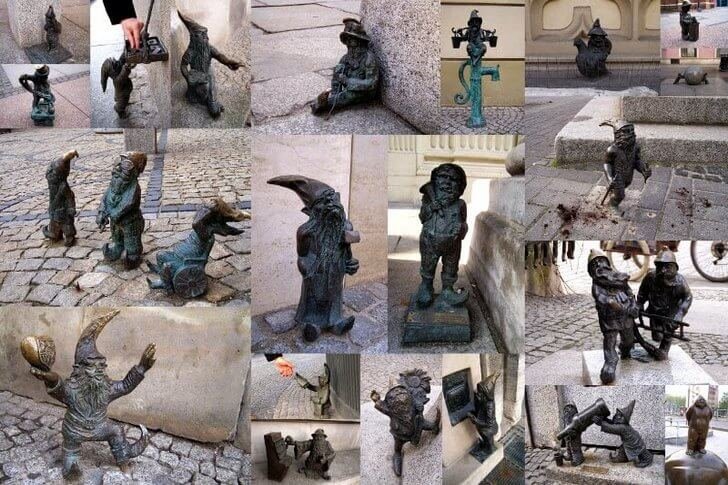
Aquapark Wroclaw
Wroclaw Aqua Park was built in 2008. It is very popular with locals and tourists. A visit to the slides will be a great alternative to lengthy walking tours of historical places and will give new strength for further walks. In addition to attractions and swimming pools, the water park has a modern SPA area with salt caves and several types of baths.
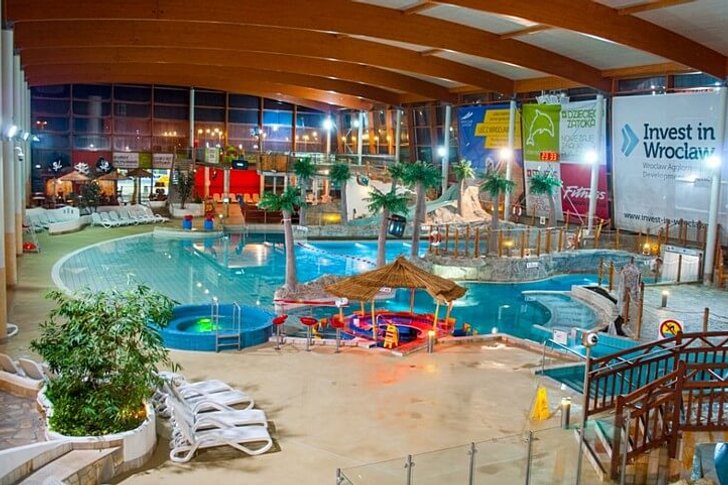
Centenary Hall and Wroclaw Fountain
The Centenary Hall is a historic building built at the beginning of the 20th century according to the project of M. Berg for the 100th anniversary of the victory over Napoleon. It became one of the earliest examples of concrete construction, for which it was included in the UNESCO list in 2006. In 2009, a color and musical fountain was put into operation next to the Hall. In the evenings, during colorful shows, jets of water soar up to 40 meters into the sky, and bizarre pictures appear on the water surface.

Sculptural group "Transition 1977-2005"
The composition is dedicated to the popular protests of 1981, when a political crisis broke out in Poland. It was created by the sculptor E. Kalina. The group consists of several figures. Some of them enter underground and personify people who went missing during the unrest, the other part, on the contrary, comes out of the ground and symbolizes the victory over the regime. The composition is dedicated to all those who suffered during the repressions.
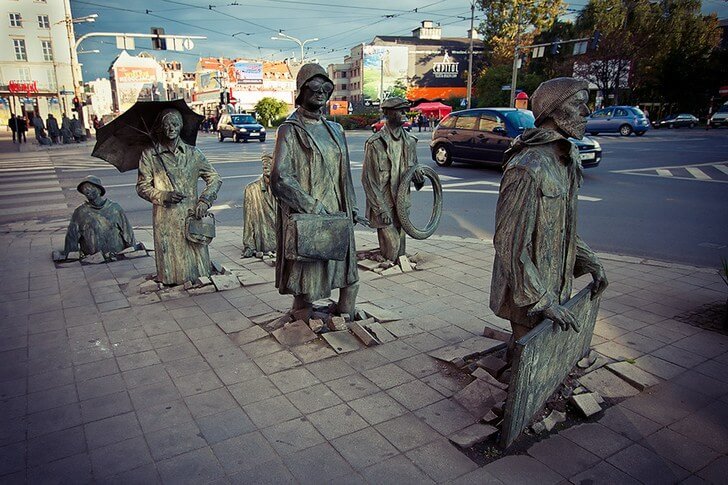
Wroclaw Cathedral
The temple was built in the XIII century. It became the first religious building in the Gothic style in Poland. Moreover, the first church built of brick. More than 70% of the building was destroyed during World War II, but part of the historic interior was still saved. After reconstruction in 1951, the cathedral was re-consecrated. Restoration work continued until 1991.

Church of St. Elizabeth
The temple is located on the northwest side of the Market Square. An impressive 90-meter tower distinguishes it from the surrounding buildings. Previously, its height was 130 meters, but after the earthquake of 1529, its dimensions decreased. The church was built at the beginning of the 14th century in the Gothic style. In the XIII century, in its place was a stone Romanesque church of St. Lawrence of Rome.
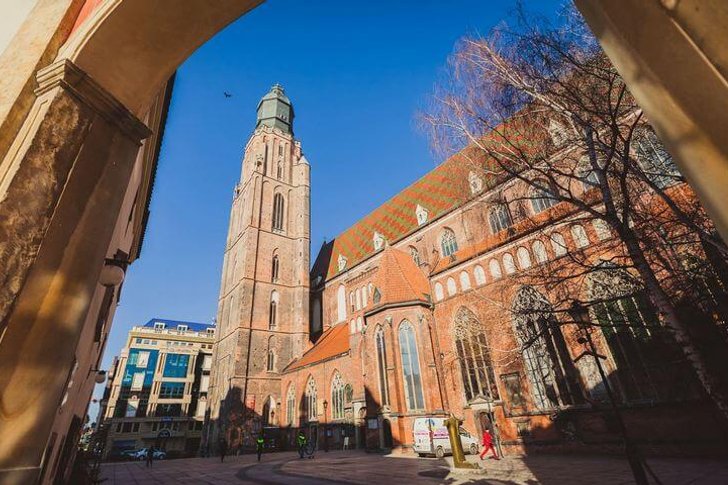
Cathedral of Saint Mary Magdalene
Gothic church of the 13th century, which was destroyed and rebuilt several times in the following centuries. Since 1525, the temple became Protestant and remained so until the end of World War II. Today, the Cathedral of St. Mary Magdalene has the status of a Catholic cathedral church. The interior of the church was partially damaged in 1945. What was left was moved to the National Museum.
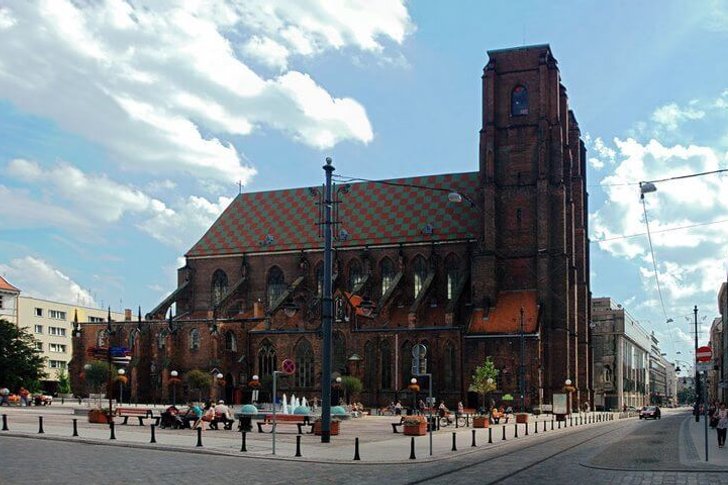
Royal Palace
The palace used to be the residence of the Prussian kings. The building was erected at the beginning of the 18th century in the style of Viennese architecture. After Silesia fell under the control of Prussia, the palace was bought by the ruler Frederick the Great and converted into his residence. In 1845, the building was rebuilt in the Renaissance style according to the project of F. A. Shtuler. After restoration in 2008, a historical museum was opened on the territory of the palace.

Shopping mall on Peschanaya street
Covered market located in one of the historical districts of Wroclaw. The complex was built in 1908 according to the design of R. Pludemann. The need to build such a structure arose because at the beginning of the 20th century Wroclaw was one of the most populous cities in Germany (at that time Poland as a state did not yet exist). Today, the market continues to be used for its intended purpose. It sells flowers, vegetables and fruits.

Houses of Yas and Malgos
Yas and Malgosya are characters from a Polish folk tale. Small houses in the center of Wroclaw, preserved from the 16th century, are named after them. Previously, bell ringers, church employees and undertakers lived in them. Today, the buildings house an exhibition gallery and the Society of Wroclaw Lovers. Houses connected by a small arch stand at an angle to each other. There used to be a cemetery behind them.
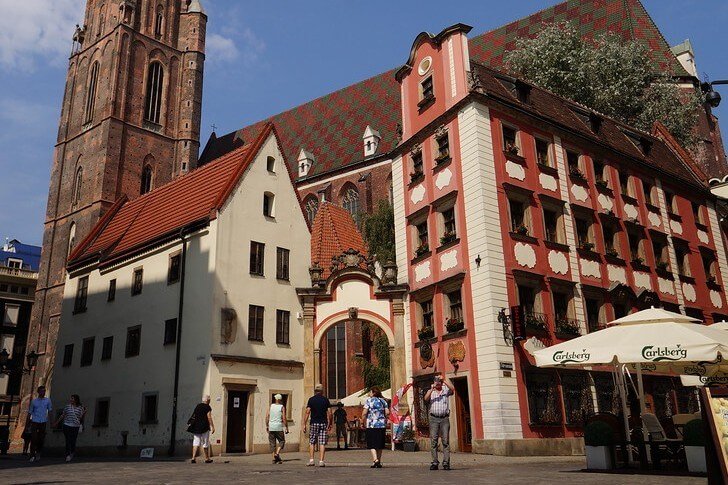
Wroclaw Opera
The building of the musical theater was erected in the 19th century according to the project of K. F. Langgans in the classical style. The names of many famous composers are associated with the opera: R. Wagner, N. Paganini, R. Strauss, F. Liszt. Immediately after the opening, dramatic performances were staged on the stage; at the beginning of the 20th century, operatic works appeared in the repertoire. The theater building is a valuable historical monument.

National Music Forum
A concert venue that combines four large halls, three chamber halls, rehearsal rooms, office space and a recording studio. The building was designed by one of the most prestigious architectural studios in Poland. The interior of the Forum is quite laconic and modern. It is made without the frills and decorations that are usually inherent in the interior decoration of a classical philharmonic.

National Museum
An art gallery that exhibits the works of the best painters and sculptors of Silesia, as well as a rich collection of products by local craftsmen. Many exhibits have moved here from churches. A separate part of the exposition is devoted to contemporary Polish art of the 20th century. The National Museum has one of the largest art collections among all Polish galleries.

Racławice panorama
The painting depicts the battle of Racławice, which took place during the Kosciuszko national liberation movement. Then the Polish rebels fought with the Russian troops. The panorama was created in Lviv in honor of the 100th anniversary of the battle. The artists V. Kossak and J. Styka worked on it. They got a grandiose canvas 114 meters long, 15 meters high and 38 meters in diameter.

Koleikovo
This is a model of the railway, which consists of 430 meters of railway track, 15 trains and several dozen cars. All this moves against the backdrop of the "revived" rural landscapes of Lower Silesia and scenes from everyday life, beautifully modeled by the creators. The model is located on the territory of the Swiebodsky railway station in the center of Wroclaw, about 800 meters from the Market Square.
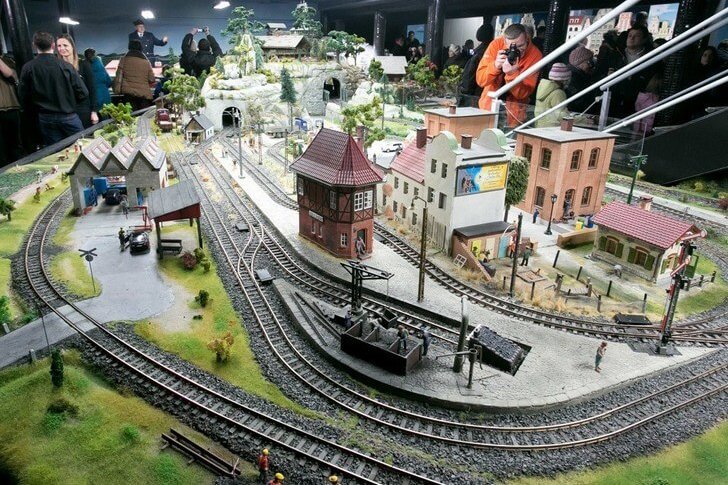
hydropolis
An interactive center where visitors can learn a lot about water. It opened in 2016 in a former underground reservoir from the 19th century, which for a long time provided Wroclaw with drinking water. Hydropolis is divided into 8 thematic zones. It is simultaneously a museum, an interactive platform for installations and a place for environmental education. Two hours are enough to view the exposition.

Wroclaw University
The educational institution was founded in 1702. At its origins was the Catholic Order of the Jesuits. At first, the curriculum consisted only of subjects in theology and philosophy. Today, more than 30 thousand students study at the university at 12 faculties. The university library contains valuable manuscripts and old books published in the Middle Ages.
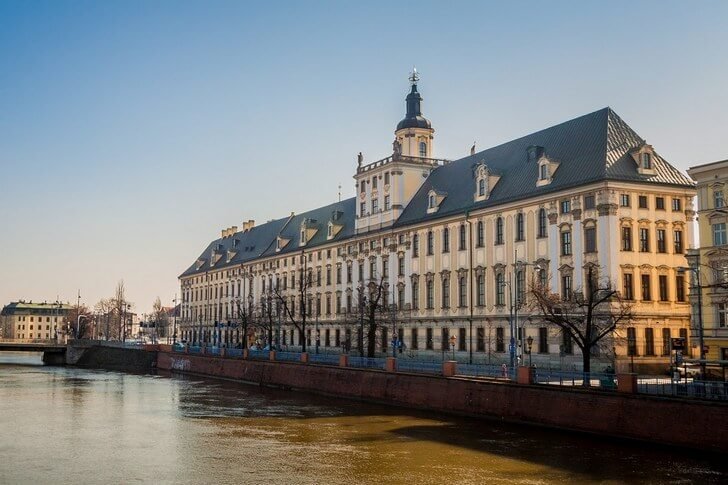
Wroclaw-Main
Wroclaw railway station, where passenger and freight trains arrive. The station was built in the 19th century, at the beginning of the 20th century it was expanded due to the increased flow of passengers. The capital reconstruction of the building was carried out in 2011-2012. The building is a typical example of European architecture. There are a lot of buildings in a similar style in the cities of Eastern Europe.

sky tower
The tallest building in Wroclaw and the third tallest in Poland. The construction of the skyscraper lasted 5 years and was completed in 2012. Today, the size of the tower reaches 212 meters along with the spire, although the original plans were more ambitious - the architects thought to build a tower of 258 meters. The Sky Tower houses residential apartments, shops, offices and service premises.

Grunwald bridge
The suspension bridge across the Oder River is 112 meters long and 18 meters wide. The structure is made of steel, brick and granite. The bridge was built in 1910 by architect R. Pludeman. The opening took place in the presence of Wilhelm II himself. The pontoon connects the center of Wroclaw with the northeastern parts of the city. Initially, it was called the Imperial, later - the Freedom Bridge.
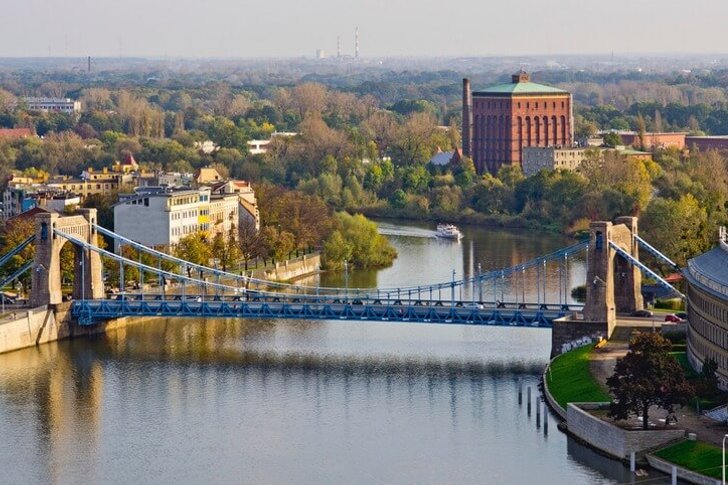
Tumsky bridge
Another bridge over the Oder river. It was built in 1889 to replace an old wooden structure. Previously, the bridge was open to car traffic, today only pedestrians are allowed to pass. The first major overhaul was carried out only in 1947. In 1976, the pontoon was recognized as a historical monument. Tourists and local youth like to gather on the Tumsky bridge.
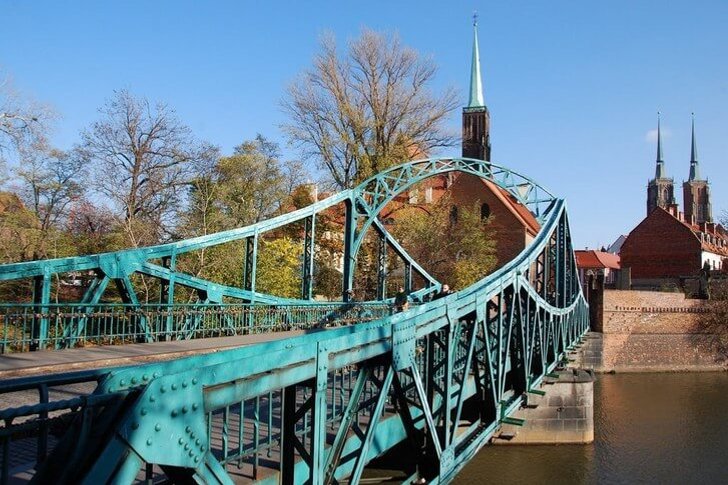
Wroclaw Zoo
The zoo was founded in 1865. Today it covers an area of 30 hectares. More than 850 species of animals (more than 7 thousand individuals) live here. The menagerie appeared in Wroclaw thanks to the initiative of Mayor J. Elvanzher. In 1862, this mayor organized a fundraiser. In 2012, an oceanarium appeared in the zoo, where more than 100 species (2600 individuals) of marine and river inhabitants settled.

Japanese garden
The Japanese garden was laid out in 1913 for the opening of the next World Exhibition, which this time was held in Wroclaw's Szczytnicky Park. A Japanese gardener and a Polish enthusiast worked on the landscape design. After the end of the exhibition, many structures were dismantled, but the park itself was preserved. After the revival in 1996, the garden turned into a real pearl of Wroclaw.
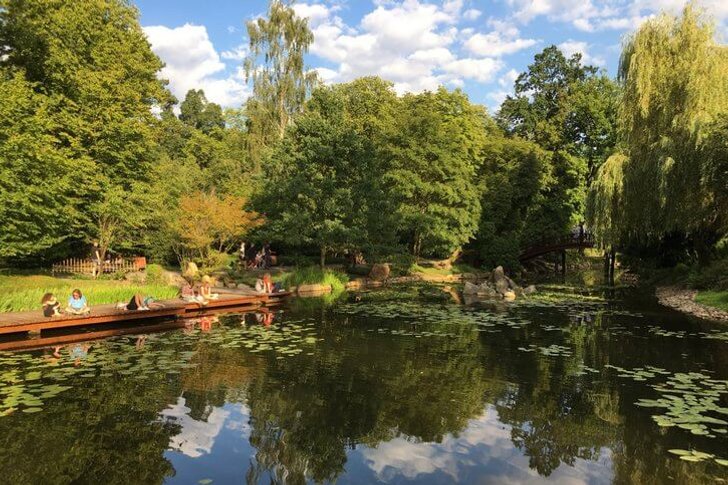
Botanical Garden of the University of Wroclaw
The park was founded in 1811. In terms of age, it is second only to the Botanical Garden of the Jagiellonian University. At first it was a small garden with medicinal plants used for research purposes, then it grew into a full-fledged garden. Several dozen trees grow here, which are considered natural monuments: plane trees, beeches, yews, oaks and ginkgo.
